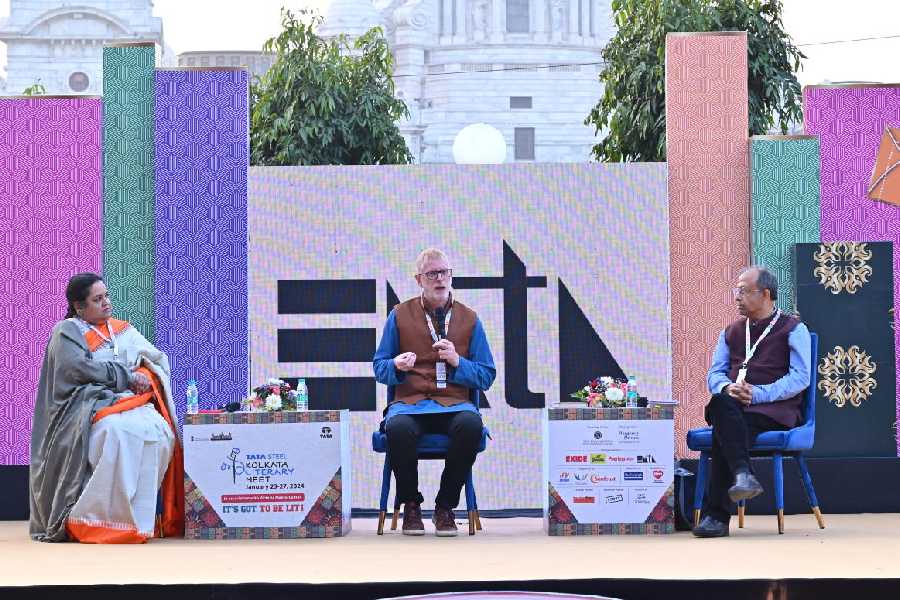The Indian identity is fluid, born out of a dynamic process, and not cast in stone.
The Indian identity, always in the making, draws from the complexities of culture and a dialogue between people. It has been shaped by waves of migration over thousands of years.
At the Victoria Memorial on Republic Day, a discussion on a book that tells the stories of the “first firangis” who set foot in India, much before the Company Raj, delved into a very topical question — who is an Indian who is not?
Like the idea of Indian-ness, the idea of firangis, or foreigners, has never remained constant. As firangis kept travelling, the idea kept acquiring new meanings and affiliations, the author said.
“We need to get outside some of the colonial understandings of identity, whether firang or Indian, to better understand the complexities of culture, a dialogue between people, the extraordinary complexity of India itself,” said Jonathan Gil Harris, professor of English at Ashoka University.
“I think despite all the talk of decolonising India that we are hearing right now from the Right as much as from the Left, there is a way in which the talk still inhabits a colonial paradigm of Indian identity, a singular Indian identity that must be purged of any trace of foreigners,” he said.
A 21st century firangi himself, Harris’s 2015 book, The First Firangis, tells the stories of “fascinating yet little-known” foreigners from the 16th and 17th centuries who decided to become Indian.
On January 26, Day IV of the Tata Steel Kolkata Literary Meet, in association with the Victoria Memorial Hall and The Telegraph, he was in conversation with Jayanta Sengupta, historian, teacher, author and director of the Alipore Jail Museum. Priyadarshinee Guha, in charge of the senior school humanities programme at Indus Valley World School, was the moderator.
Tale of Tibaut
One of the characters in the book is a Portuguese
named Sebastian Gonzales Tibaut, born in 1582 in a fishing village south of Lisbon.
Harris said he was “press-ganged to serve in a Portuguese galleon” that brought him to the southwestern shores of India, the Estado Da India (Portuguese State in India).
Tibaut’s journey took him to Chittagong, off the Bay of Bengal, then to Sandwip, an island just south of the Sunderbans. He became a merchant, then became a raja, got married to, and had a son with, the sister of the raja of the Irrawaddy region (in Burma). It was a time when the Mughals and the Arakhans (from Burma) were vying for supremacy in the Bay of Bengal.
“Chittagong was at this time a kind of a stateless city. It was one of these port cities that involved an extraordinary multicultural ray of people who were looking to make some kind of a living,” said Harris.
Tibaut’s descendants came to be a mix of Portuguese, Arakhan and Bengali. There is a part of Chittagong, just next to the port, called Firingi Bazar, where a cathedral still stands.
“There are still people with names like Perreira and Oliviera, whose skin is as dark as the night, who are Bangladeshi, who speak Bengali but are descended from Sebastian Gonzales Tibaut,” said Harris.
Firangi
The British Raj considered these people as a separate and inferior race.
“But I think of the firangis as a fascinating example of how we need to think outside of the colonial mindset to get a handle on a tale of miscegenation, of cultural heterogeneity, that, rather than being exceptional, is much more the norm in the subcontinent,” said Harris.
Firangi is a word that has migrated from elsewhere to the subcontinent and became desi.
“Firangi is a word that derives from an Arabic mishearing or a rendering of what the French (who landed during the First Crusade) called themselves. The Arabs called them ferengis. Ferengi migrated to Persia and became firangi. Firangi migrated to the subcontinent. It was picked up, in Urdu, Hindi, and many other languages. In Bengal, it has developed into firingi. In the south, in Tamil Nadu, it has become parangi. It has migrated even farther to Malaysia,” he said.
“It is a word that keeps acquiring new lives and new locations, just as these firangs that it describes have not remained consistently one thing through their migrations, but have sort of acquired new meanings, new affiliations and new senses of themselves.”
Borrow, then own
Sengupta said the book was a “corrective” to a unitary and exceptionalist idea of India.
“As citizens living in these unfortunate times, we are always willy-nilly involved in a battle for the idea of India. There is a strong group that tries to argue that who is an Indian and who is not is defined by a very unitary, exceptionalist, self-contained idea of India. As if India has always been a bubble.
“It is a very incorrect imagination of India because India has shamelessly borrowed things from all over the world. Over time, those borrowed things have become projected as prototypically authentic,” said Sengupta.
